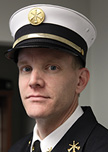Editor’s Opinion Chris Mc Loone

At face value, one might think there has been a major increase in fire apparatus accidents in recent years.
This is likely true to an extent, but probably more to do with how easy it is to find out about them these days. The crashes are sometimes operator error: The driver goes off the side of the road a little and overcorrects, causing the rig to roll or doesn’t “let an intersection breathe,” as Tim Curran mentioned in his April 2024 article on driver training, and a rig collides with a civilian vehicle. Sometimes these crashes are on the highway, where a rig is parked in a blocking position and a civilian driver hits it.
Along the way, we’ve stressed the importance of recognizing how the physical characteristics of these vehicles impact how they handle on the road and have emphasized adjusting driving techniques accordingly. We’ve surmised that newer apparatus operators have never driven vehicles that large before. We’ve covered driving simulators for use at the beginning of driver training. Industry vendors have introduced ways for fire apparatus to communicate with drivers we share the road with who may be distracted, warning of our approach.
Sometimes drivers don’t do what we expect them to do. As I write this, just yesterday I drove one of our pumpers to an odor of gas inside a commercial building. As we approached an intersection, the vehicle in front of us, instead of bearing right to let us go, went left. Puzzling for sure, but sometimes people hear an air horn and the Q and don’t have any idea what to do. And, we’ve installed traffic interceptor devices at intersections to help our fire apparatus call for the intersection.
It’s the last item there that has me thinking. Yes, we’re being made aware more often about fire apparatus crashes. But, apparatus crashes at intersections with other apparatus—especially with all the technology we’ve got in place—are unacceptable in this day and age.
A recent crash involved a rescue truck and a tractor-drawn aerial both responding to the same call. The call was for a structure fire, and it was a working job. The crash occurred when one rig made a left turn in front of the other at an intersection. The apparatus making the left did not have a green light; the rig going straight did. In fact, the vehicle going straight had the green because of a preemption system installed. Six firefighters were injured in the crash, and both vehicles sustained serious damage. Six firefighters and two rigs could no longer respond to residents in need. The driver of the vehicle making the left turn was cited for a red-light violation.
This accident was 100% preventable. When you come to a red light, you stop. There is no way of knowing if the intersection is clear and, if it is, if someone getting impatient is trying to pass the line of cars unless you stop. In the above case, one rig had the green, and one had the red. If one stopped, no accident—at least not with another fire truck.
What do we do? Stopping at the red is one thing. If you’ve got the green, slow down anyway. It’s an intersection. How often have you been at a red light, and it turned green, but someone completely ignored the red light and went through? Or, that person thought he was going to beat out a yellow light and mistimed the whole thing. Waiting that extra second is what Curran considers letting the intersection breathe.
Know your local and know where other companies are coming from and let them know when you’re about to cross paths. Communicate. Don’t make the drivers guess. Officers, announce what you’re going to do. If you have the green and the other rig needs to make the turn but has the red, there’s nothing wrong with saying, “Go ahead, 101.” The civilian drivers are confused enough about what is going on—there’s no need for the apparatus operators to be.
Rig-to-rig crashes are, for the most part, preventable. Yes, accidents do happen. But, when circumstances are within our control, there is no reason for having to protect ourselves from ourselves.

